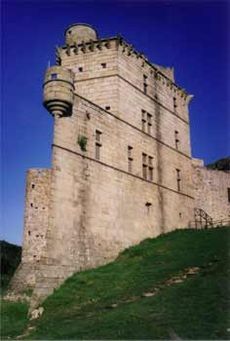
Château de Portes
Encyclopedia

Castle
A castle is a type of fortified structure built in Europe and the Middle East during the Middle Ages by European nobility. Scholars debate the scope of the word castle, but usually consider it to be the private fortified residence of a lord or noble...
located in the commune
Communes of France
The commune is the lowest level of administrative division in the French Republic. French communes are roughly equivalent to incorporated municipalities or villages in the United States or Gemeinden in Germany...
of Portes
Portes, Gard
Portes is a commune in the Gard department in southern France.-Population:-References:*...
in the Gard
Gard
Gard is a département located in southern France in the Languedoc-Roussillon region.The department is named after the River Gard, although the formerly Occitan name of the River Gard, Gardon, has been replacing the traditional French name in recent decades, even among French speakers.- History...
département of France
France
The French Republic , The French Republic , The French Republic , (commonly known as France , is a unitary semi-presidential republic in Western Europe with several overseas territories and islands located on other continents and in the Indian, Pacific, and Atlantic oceans. Metropolitan France...
. It overlooks the Regordane, an ancient avenue used by the pilgrims of Saint-Giles and the Croisés on their way towards the Holy Land for a distance of ten miles. Anduze
Anduze
Anduze is a commune in the Gard department in southern France.-Population:-References:*...
, Randon and Polignac
Polignac
Polignac is the name of several communes in France:* Polignac, Charente-Maritime* Polignac, Haute-Loire, in the Haute-Loire département, dominated by the fortress Château de Polignac with its square donjon tower, 32 m tall...
paid homage to the abbot of Saint-Pierre-de-Sauve for this castle between the 11th and the 14th centuries. The castle is listed as a monument historique
Monument historique
A monument historique is a National Heritage Site of France. It also refers to a state procedure in France by which national heritage protection is extended to a building or a specific part of a building, a collection of buildings, or gardens, bridges, and other structures, because of their...
by the French Ministry of Culture.
History
Raymond Guillaume de Budos, the nephew of Pope Clement V, bought the seigniory in 1322, and added at least two additional flanks to the castle in 1384. Thibaud de Budos recovered the castle after deposing his father André, who had joined with the English at the beginning of the Hundred Years' WarHundred Years' War
The Hundred Years' War was a series of separate wars waged from 1337 to 1453 by the House of Valois and the House of Plantagenet, also known as the House of Anjou, for the French throne, which had become vacant upon the extinction of the senior Capetian line of French kings...
.
The seigniory became increasingly rich and powerful until Louis XII set it up as a marquisat in favour of Antoine Hercules de Budos, to whom is undoubtedly owed the form of the present castle. His father was a bishop of Agde, one of his sisters a duchess of Montmorency
Montmorency
- Places :In Australia:* Montmorency, Victoria, suburb of Melbourne** Montmorency railway stationIn Canada:* Montmorency Falls, Quebec* Montmorency , Quebec* Montmorency , Quebec...
, and another the abbess of "l'Abbaye des Dames" (The Abbey of Dames) in Caen
Caen
Caen is a commune in northwestern France. It is the prefecture of the Calvados department and the capital of the Basse-Normandie region. It is located inland from the English Channel....
. The Maréchal-de-Camp was killed in the siege of Privas
Privas
Privas is a commune of France, capital of the Ardèche department. It is the second-smallest administrative center of any department in France, larger than only the commune of Foix. It is the fifth-largest commune in the Ardèche, behind Annonay, Aubenas, Guilherand-Granges, and Tournon-sur-Rhône. It...
in 1629. His daughter, Marie-Félice, left the castle as an heirloom to her nephew, Prince de Conti, in 1693, whose descendants sold it to Louis XVI in 1781.
With the French Revolution
French Revolution
The French Revolution , sometimes distinguished as the 'Great French Revolution' , was a period of radical social and political upheaval in France and Europe. The absolute monarchy that had ruled France for centuries collapsed in three years...
, the castle was nationalised and sold to six successive owners. In 1841, in the hands of the Vernede family, the monument was restored from its decrepit condition.
In 1929, following the intensive exploitation of the coal mines under the site, the ground broke down ruining the castle and forcing its evacuation. The village was rebuilt about 300 metres further. Circa 1960, the grounds were stabilised and in 1972 an association was formed to recover the castle. It has been classified as a historical monument since 1984.
Architecture
The castle has a singular architectural style among castles in Europe because of its 49 degree spursSpur (architecture)
A spur , in architecture, is the ornament carved on the angles of the base of early columns.-Ornament:A spur consists of a projecting claw, which, emerging from the lower torus of the base, rests on the projecting angle of the square plinth.-Ancient Roman architecture:It is possibly to these that...
in the shape of a ship's bow
Bow (ship)
The bow is a nautical term that refers to the forward part of the hull of a ship or boat, the point that is most forward when the vessel is underway. Both of the adjectives fore and forward mean towards the bow...
, which earned the castle its nickname of a vessel in the Cévennes .

